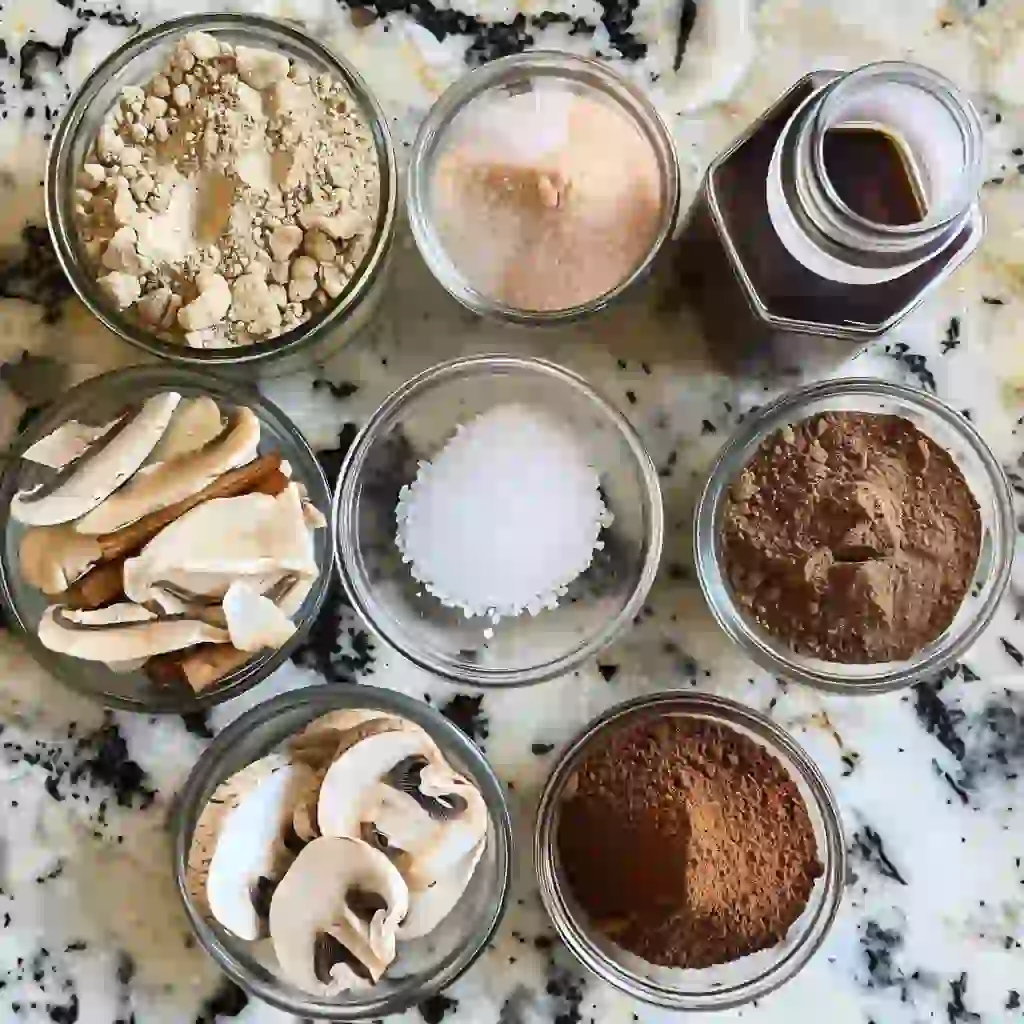Introduction
Mushroom-Based Slimming Coffees are one of the most intriguing health trends I’ve come across in recent years—and trust me, as someone who’s tried everything from turmeric teas to spirulina smoothies, I don’t say that lightly. I first stumbled upon these earthy brews while traveling through Oregon, where a local barista handed me a steaming cup of “lion’s mane mocha.” The taste? Surprisingly smooth. The energy? Steady and focused. But what truly caught my attention was its growing reputation in the weight-loss and wellness communities.
So, I did what any curious home cook would do—I started brewing my own versions in my kitchen, playing with different mushroom powders, natural sweeteners, and plant-based creamers. Over time, I found myself drinking less traditional coffee and more of these calming, adaptogenic blends that seemed to support my digestion and curb those mid-morning snack cravings.
In this guide, I’ll take you through everything I’ve learned about mushroom-based slimming coffees—from how they might help with weight loss to which mushrooms to look for, how to prepare them, and what to expect if you’re just getting started. I’ll also share my personal experiences, tips for daily use, and answer the most common questions people ask.
Looking for a refreshing option to balance your coffee habit? Discover Moringa Detox Water—a gentle natural cleanse to support hydration.
Let’s get started.
Table of Contents
Understanding Mushroom-Based Slimming Coffees
What Are Mushroom-Based Slimming Coffees?
When I first heard the term mushroom-based slimming coffees, I pictured a steaming mug with a portobello floating in it—not exactly appealing. But these drinks aren’t made with pizza mushrooms. Instead, they use finely ground medicinal mushroom extracts like lion’s mane, chaga, cordyceps, and reishi—each known for their adaptogenic and wellness benefits rather than their flavor.
These mushrooms are blended with regular or decaf coffee and sometimes even with herbal roots like chicory or adaptogens such as ashwagandha. The result? A warm, earthy beverage that gives energy and may support metabolism, reduce stress-related cravings, and promote more balanced focus—all without the crash of standard coffee.
From my experience, mushroom-based slimming coffee offers a gentler lift. I used to feel wired after a single espresso shot. But with these brews, I stay steady and even-tempered through the morning—and that alone is worth the switch.
The Rise of Functional Coffee in the Wellness World
The functional coffee movement is growing fast—and for good reason. Coffee today is about more than just staying awake; it’s about feeling your best. As someone who’s always trying new ways to support digestion and energy naturally, I’ve been drawn to options that work with my body, not against it.
That’s exactly what mushroom-based slimming coffees offer. They bridge ancient herbal traditions with modern nutritional thinking. These drinks blend earthy mushrooms with smooth, familiar coffee flavors—so you still get that warm morning ritual, just with added benefits.
And this trend is popping up everywhere. Brands like RYZE, Mud/Wtr, and Four Sigmatic now offer easy-to-prepare blends that claim to support mental clarity, gut health, and weight management. While I always take health claims with a grain of salt, I have to admit: I genuinely enjoy how calm and nourished I feel after sipping one.
Mushroom-based slimming coffees may not be magic, but for me, they’ve become a consistent, soothing part of a mindful wellness routine.
Curious how others approach natural fat-burn routines? Check out my experience with Moringa Detox Water for weight loss—you may find the balance you’re looking for.

Mushroom-Based Slimming Coffees – The Ultimate Guide to This Trending Weight-Loss Brew
An earthy, wellness-focused alternative to regular coffee, mushroom-based slimming brews combine functional fungi like lion’s mane, chaga, and cordyceps for a calming, metabolism-supporting cup that fits perfectly into a clean eating routine.
- Total Time: 5 minutes
- Yield: 1 cup 1x
Ingredients
- 1 tsp organic instant coffee (or brewed black coffee)
- ½ tsp cordyceps mushroom powder
- ½ tsp lion’s mane mushroom powder
- ¼ tsp cinnamon
- 1 tsp coconut oil (optional)
- 1 cup hot water or plant-based milk
- A pinch of pink salt
- Stevia or monk fruit sweetener to taste
Instructions
- Heat your water or milk until steaming, not boiling.
- In a mug, mix the coffee, mushroom powders, cinnamon, and salt.
- Add coconut oil if using.
- Pour in the hot liquid and whisk or blend until frothy.
- Taste and sweeten as needed.

Notes
Add nutmeg, cardamom, or cacao for extra flavor. Avoid artificial creamers or overheating the mix to preserve benefits.
- Prep Time: 5 minutes
- Cook Time: 0 minutes
- Category: Drinks
- Method: No Cook
- Cuisine: Wellness
Nutrition
- Serving Size: 1 cup
- Calories: 65
- Sugar: 0g
- Sodium: 100mg
- Fat: 5g
- Saturated Fat: 4g
- Unsaturated Fat: 1g
- Trans Fat: 0g
- Carbohydrates: 2g
- Fiber: 0g
- Protein: 1g
- Cholesterol: 0mg
How Mushroom Coffees May Support Weight Loss
Metabolism Boosting Properties of Medicinal Mushrooms
Let me be clear—mushroom-based slimming coffees aren’t magic potions. But from what I’ve observed in my own routine, they may support gentle, natural changes in how your body feels and functions, especially over time.
Many of the mushrooms used in these blends—like cordyceps and chaga—are traditionally linked to improved energy and stamina. Cordyceps, in particular, has a long history in Tibetan and Chinese medicine, where it’s used to enhance physical endurance. Personally, I’ve noticed fewer energy crashes throughout the day, which helps me stay consistent with workouts and mindful eating.
Reishi and lion’s mane, on the other hand, are often tied to stress relief and mental clarity. And that’s important because when I feel more grounded, I make better choices—less impulsive snacking, more thoughtful meals. Small wins like that add up.
Some mushroom-based slimming coffee blends also include metabolism-friendly extras like green tea extract, cinnamon, or ginger. These ingredients aren’t just tasty—they’re warming and may aid digestion. I find that when I start my day with a mushroom latte instead of black coffee, I feel more balanced and less bloated.
Adaptogens, Stress, and Their Role in Weight Management
One of the biggest things I’ve learned on my health journey is that stress and weight are more connected than we think—especially when it comes to stubborn belly fat. That’s where adaptogens come in.
Mushrooms like reishi and lion’s mane are adaptogenic, meaning they may help the body respond calmly to emotional or physical stress. I used to be a textbook stress-eater. But when I started swapping my second cup of strong coffee for a calming mushroom blend, my cravings eased off and my snacking slowed down.
Now, I’m not saying mushroom-based slimming coffees burn fat directly. But they can support lifestyle shifts—lower stress, improved focus, better digestion—that contribute to long-term weight management. In my case, they helped lighten both my mindset and my meal routine.
Don’t miss our favorite metabolism boosters like this ACV and Cayenne Pepper morning ritual—a perfect complement to your slimming mushroom coffee.
Key Mushroom Types Used in Slimming Coffees
Lion’s Mane, Cordyceps, and Chaga: What They Offer
When I first started experimenting with mushroom-based slimming coffee, I was overwhelmed by the sheer number of mushroom types out there. But after weeks of sipping, reading, and testing blends, I narrowed it down to a few staples that show up consistently—and for good reason.
Lion’s Mane quickly became a favorite. While it’s often promoted for brain health and focus, I found it especially helpful during busy mornings. It gives me mental clarity without the spike-and-crash cycle of traditional coffee. And as it turns out, better cognitive function can lead to more mindful eating—something I’ve definitely noticed.
Then there’s Cordyceps, which I think of as the “energizer mushroom.” Some athletes even use it to support endurance. I wouldn’t run a marathon on cordyceps alone, but it definitely helps me power through my early-morning walks without feeling winded. That steady, sustainable energy has helped me stick to my active lifestyle.
Chaga, the earthy, slightly bitter mushroom, stands out for its antioxidant properties. Many say it’s excellent for immune support, but I really love how grounding it tastes. Chaga blends seem to reduce bloating and help me feel fuller longer—especially when paired with a fiber-rich breakfast.
Together, these mushrooms form the core of most mushroom-based slimming coffee, each contributing its own benefits to the blend.
Which Mushrooms Are Most Common for Fat-Burning Blends?
If you’re browsing the market, you’ll likely come across a mix of these mushrooms in most fat-burning or weight-supporting blends. These are the key players I see most often—and the ones I come back to in my own coffee routine:
| Mushroom | Known For | What I Noticed |
|---|---|---|
| Cordyceps | Energy, stamina | Less mid-day fatigue, better workout consistency |
| Lion’s Mane | Mental clarity | Sharper focus, fewer snack-related decisions |
| Reishi | Stress balance | Calmer mood, reduced sugar cravings |
| Chaga | Antioxidants, gut balance | Less bloating, more regular digestion |
These functional fungi don’t instantly melt fat—but they do support habits that make lasting changes possible. When paired with hydration, nutritious meals, and movement, I did start noticing shifts in how I felt, and how my clothes fit.
Comparing Top Brands of Mushroom Slimming Coffees
Honest Review: RYZE, Mud/Wtr, and Four Sigmatic
When I dove into the world of mushroom-based slimming coffee, I decided to test out a few well-known brands to see which one best suited my taste, lifestyle, and budget. I gave each a solid week of use, folding them into my morning or afternoon routine. Here’s how each one performed from a real-life perspective:
| Brand | Taste | Energy | Price | Key Ingredients |
|---|---|---|---|---|
| RYZE | Creamy, earthy | Mild, steady boost | $$ | Cordyceps, Lion’s Mane, Reishi |
| Mud/Wtr | Spiced chai-like | Light, relaxing | $$$ | Chaga, Reishi, Cinnamon, Turmeric |
| Four Sigmatic | Bold, coffee-forward | Strong focus | $$ | Lion’s Mane, Chaga, Arabica coffee |
RYZE blended seamlessly into my mornings. It paired well with oat milk, had a pleasant creamy texture, and lacked the jittery crash I sometimes get with traditional brews. I especially liked how it mellowed my mood without dulling my energy.
Mud/Wtr had a cozy, spiced aroma and a chai-like taste. I found it better for evenings or wind-down routines. It’s caffeine-free, so it became a comforting ritual rather than a stimulant hit—an interesting addition to the mushroom-based slimming coffee category.
Four Sigmatic delivered the most coffee-like flavor. With a bolder taste and stronger energy effect, it gave me the edge I needed during deep work sessions. If you’re used to full-strength coffee but want the benefits of functional mushrooms, this one bridges both worlds well.
Each of these mushroom-based slimming coffee is built around ingredients that support energy, digestion, and immunity. But the biggest win for me? They helped replace calorie-heavy lattes and sugary drinks—without sacrificing the joy of a warm morning cup.
Which Is Best for Belly Fat Concerns?
To be honest, no drink—including mushroom-based slimming coffee—melts belly fat on its own. But what they can do is support routines that lead to healthier choices.
RYZE was my personal favorite for this. I found that it helped me skip mid-morning snacking and stay fuller until lunch. That consistency, over time, played a role in how my clothes fit and how I felt overall.
If your goal is to support belly fat loss through habits—not hype—I’d suggest starting with RYZE in the morning and pairing it with a balanced, protein-rich breakfast.
Preparing Your Own Mushroom Coffee at Home
Sifaw’s Favorite DIY Slimming Mushroom Coffee Recipe
After testing various store-bought blends, I decided to take control of the flavor and function in my cup. The result? A deeply satisfying, DIY version of mushroom-based slimming coffee that’s affordable, simple, and personalized. It’s the blend I come back to whenever I want that earthy richness with a gentle metabolic lift.

Here’s my go-to recipe for home brewing:
Ingredients of mushroom-based slimming coffee
- 1 tsp organic instant coffee (or brewed black coffee)
- ½ tsp cordyceps mushroom powder
- ½ tsp lion’s mane mushroom powder
- ¼ tsp cinnamon
- 1 tsp coconut oil (optional for satiety)
- 1 cup hot water or plant-based milk
- A pinch of pink salt
- Stevia or monk fruit sweetener to taste
Instructions
- Heat water or milk until hot, but not boiling.
- In a mug, combine the coffee, mushroom powders, cinnamon, and salt.
- Add coconut oil if you’re using it.
- Pour in the hot liquid and whisk or blend until smooth and frothy.
- Sweeten to taste and enjoy.
This homemade version of mushroom-based slimming coffee keeps me energized and full for hours—without the crash. Plus, I love knowing exactly what’s in my cup. No mystery ingredients or hidden sugars.
What to Add (or Avoid) for Flavor and Benefits
If you’re new to making your own mushroom-based slimming coffees, keep in mind: the earthy flavor can take some getting used to. But with the right tweaks, you can make it delicious.
To Boost Flavor:
- Add a splash of unsweetened vanilla almond milk
- Mix in a teaspoon of cacao powder for a mocha twist
- Try a pinch of nutmeg or cardamom for extra warmth
To Avoid:
- Artificial creamers—they often cancel out digestive or anti-inflammatory benefits
- Heavy sweeteners—stick to monk fruit, stevia, or a little raw honey
- Overheating—super hot water can degrade the mushrooms and affect the blend’s benefits
Making your own version at home not only saves money, but also gives you full control over your ingredients and flavor profile. It’s one of the easiest ways to start integrating mushroom-based slimming coffees into a mindful wellness routine.
My Personal Experience with Mushroom-Based Slimming Coffee
Why I Tried It: My Curiosity and Journey
It all started during a chilly fall in Portland. I’d just come back from a long weekend road trip, feeling sluggish and overloaded on diner coffee and heavy snacks. A friend of mine handed me a mug of something she called “mushroom magic.” I gave her a side-eye, but curiosity won. One sip later, I was hooked—not just by the flavor, but by how it made me feel.
As someone who’s always looking for gentle, natural ways to support digestion and curb cravings, mushroom-based slimming coffee felt like a perfect experiment. I wasn’t trying to lose 20 pounds overnight—I just wanted something that made me feel balanced and less jittery than regular coffee. So I committed to swapping my usual morning brew for a mushroom blend for 30 days.
What I Noticed After 30 Days
Let me tell you—those 30 days were eye-opening.
In the first week, I noticed my energy levels became more stable. No crash at 11 AM. No wild sugar cravings by 2 PM. Just smooth, steady focus.
By the second week, my digestion had improved. I felt lighter after meals and didn’t experience that midsection bloat that used to show up like clockwork. I paired my mushroom coffee with fiber-rich breakfasts like oats or chia pudding, and the combo worked wonders.
By the third and fourth weeks, my snacking habit slowed. I realized I wasn’t using food as a stress-relief tool quite as often. That’s when I knew something was shifting—not just physically, but mentally.
No, I didn’t drop three dress sizes. But I did lose about 3 pounds naturally. More importantly, I felt good in my skin again—calm, energized, and less reactive to stress. That’s a win in my book.
Health Considerations and Side Effects
Who Should Be Cautious About Mushroom Coffees?
As much as I enjoy mushroom-based slimming coffees, they’re not for everyone. I always recommend listening to your body and doing a little homework before adding any new ingredient to your daily ritual.
From what I’ve read—and from talking with holistic-minded friends—those with autoimmune conditions, pregnant or nursing women, or people on blood pressure or diabetes medications may want to consult with a healthcare provider before drinking medicinal mushrooms regularly. These mushrooms interact with the body’s natural systems, and that’s powerful stuff—especially if you’re already on a treatment plan.
If you’re sensitive to mushrooms in general, you might want to start with a tiny dose and work your way up. I had a close friend who got mild nausea from a high dose of cordyceps. Turns out, a half scoop was just right for her.
For folks with caffeine sensitivity, check the label. Some blends contain real coffee, while others are caffeine-free. I personally do fine with the caffeinated ones in the morning—but not after 2 PM.
The Downside of Mushroom Coffee – What to Know
Let’s be real: mushroom coffee isn’t a miracle fix. And it isn’t always delicious at first sip. Here are a few things I learned the hard way:
- Taste can be earthy or bitter. It took me about a week to adjust my palate. Adding spices like cinnamon and nutmeg helped a lot.
- Pricey for some. High-quality mushroom blends aren’t cheap. That’s why I started making my own, which saved me a lot.
- Potential digestive changes. I noticed that chaga made me visit the bathroom more often—nothing dramatic, but something to be aware of.
- Not all brands are transparent. Some don’t list mushroom extract percentages. I stick to brands that do.
That said, the upsides—smoother energy, fewer cravings, more mindfulness—made the minor downsides worth it for me.
Tips for Making Mushroom Slimming Coffee Part of Your Routine
Morning Rituals: How I Swapped Out Regular Coffee
For years, my morning ritual revolved around a strong cup of dark roast and a running mental to-do list. But once I discovered mushroom-based slimming coffees, that all shifted in the most grounding way.
Instead of jolting myself awake with intense caffeine, I now start with a slow breath, warm water, and my daily mushroom brew. I keep it simple—one scoop of powder, hot oat milk, and a pinch of cinnamon. On days when I need a little extra staying power, I’ll stir in some collagen or a splash of MCT oil for creaminess and satiety.

Here’s what helped me transition to mushroom-based slimming coffees without giving up the comfort of a warm cup in the morning:
- Gradual replacement – I didn’t go cold turkey. I started by mixing half mushroom blend, half regular coffee. After about two weeks, I fully made the switch.
- Flavor tweaks – I added cacao or vanilla to make the drink feel more indulgent and familiar.
- New ritual cues – I paired my cup with a 5-minute journaling session. That reset helped me associate the drink with calm, not chaos.
The result? I now genuinely look forward to it. Mushroom-based slimming coffee has become a small but powerful ritual—one that feels like a reset rather than a rush.
Pairing It with a Clean Eating Plan
From my experience, mushroom-based slimming coffees work best as part of a supportive routine—not a magic fix. When I pair my morning mug with whole-food, fiber-rich meals, I feel full longer and avoid that mid-morning energy crash.
Here are a few go-to combinations that keep me feeling energized and nourished:
| Mushroom Coffee Time | What I Eat With It |
|---|---|
| Morning (7–9 AM) | Oats with flax and berries, or eggs with spinach |
| Mid-Morning Pick-Me-Up | Apple with almond butter or chia pudding cup |
| Afternoon Chill (decaf blend) | Herbal crackers with hummus or veggie soup |
Hydration is another game changer. I always drink a glass of water before and after my coffee—it helps balance digestion and reduce any drying effects.
FAQs About Mushroom-Based Slimming Coffees
Does mushroom coffee really work for losing weight?
From my personal experience, mushroom-based slimming coffees supported my wellness routine in meaningful ways. They aren’t weight-loss miracles, but when paired with mindful eating and regular movement, they can help. Cordyceps may support stamina, and reishi has helped me reduce stress-related cravings. The biggest win? I felt balanced—fewer energy dips, more motivation, and much less mindless snacking.
What is the downside of mushroom coffee?
For me, the main downside of mushroom-based slimming coffees was the taste—at first. The earthy flavor took some getting used to, but once I added cinnamon and a splash of oat milk, it became something I truly enjoyed. Another challenge is that some brands under-dose their mushrooms or include hidden additives. That’s why I always check the label and buy from companies that are transparent with their sourcing and dosages. And of course, if you have any medical conditions or take medications, speak with your doctor before trying functional mushrooms.
Does RYZE coffee help lose belly fat?
I can’t say that mushroom-based slimming coffees like RYZE directly target belly fat. However, RYZE did help me stay full longer and reduced my morning snacking. When paired with a clean diet and movement, I noticed positive body changes over time—especially around the belly area. It’s not about instant results, but building sustainable habits. RYZE gave me the steady energy and mental focus to stick with those habits consistently.
Is there a mushroom that helps with weight loss?
While no mushroom melts fat on its own, several have properties that may support healthy weight management. Cordyceps is often used to support energy and endurance. Reishi is known for its calming adaptogenic effects, which may help reduce stress eating. Chaga supports digestion, helping you feel more comfortable and satisfied. When these are combined into mushroom-based slimming coffees, I found it easier to stay active, plan meals, and feel more in tune with my body.
Conclusion
Mushroom-based slimming coffees aren’t a magic bullet—but in my experience, they’ve made a real difference. They support a more balanced, sustainable lifestyle by promoting focus, reducing cravings, and giving me calm, grounded energy. Whether I’m reaching for a trusted brand like RYZE or blending my own at home, these brews have become more than just a morning drink—they’re a mindful ritual.
What makes mushroom-based slimming coffees special isn’t just their ingredients. It’s how they encourage a slower, more intentional rhythm to the day. I no longer crash by 10 a.m. or snack my way through the afternoon. Instead, I feel steady and clear—like I’m working with my body, not against it.
That said, these coffees work best when they’re part of a bigger picture. If you’re pairing them with whole foods, hydration, movement, and rest, you’ll likely feel the shift too. They’re not the star of the show—but they’re a valuable supporting character.
If you’re just getting started with mushroom-based slimming coffees, my advice is to keep it simple:
- Start with one cup a day, ideally in the morning
- Choose a clean blend with transparent ingredients
- Pair it with a whole-food meal (not a donut!)
- Stay consistent for at least 2–3 weeks
I like to think of it as nourishment in a mug. Not just for my body—but for my routine, focus, and mindset.
For keto fans, this herbal bone broth electrolyte blend makes a nourishing partner to mushroom-based slimming coffees.
Follow along for more kitchen-tested, lifestyle-friendly ideas:
Connect on Facebook | See fresh ideas on Pinterest








3 thoughts on “Mushroom-Based Slimming Coffees – The Ultimate Guide to This Trending Weight-Loss Brew”